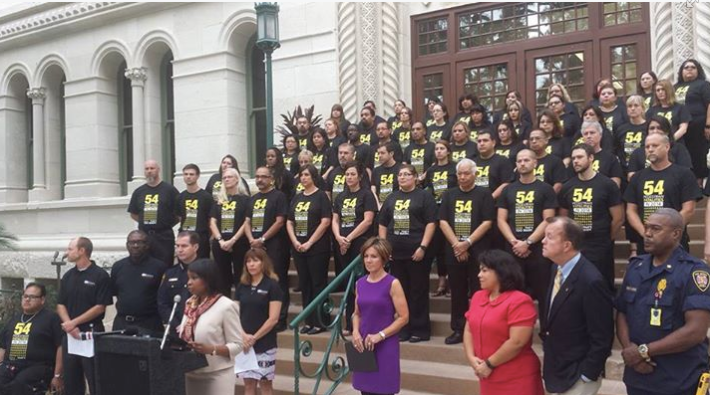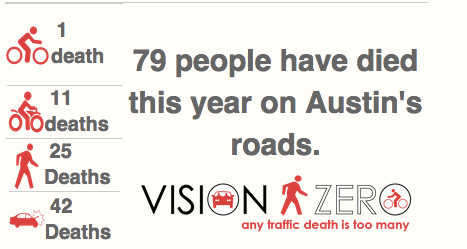The Movement to Eliminate Traffic Deaths Gains Strength in Texas Cities
2:25 PM EDT on September 24, 2015

Texas cities are some of the most dangerous places in the U.S. to walk or bike -- or drive, for that matter.
In 2013, the per capita traffic death rate in Texas was 24 percent higher than the nation as a whole. And because so many people live in the state, it regularly leads the nation in total traffic deaths.
Walking in Texas cities can be particularly perilous. Adjusted for population, the Lone Star State is the 10th most dangerous for walking. Houston, Dallas, and San Antonio are all on the list of the 20 most dangerous cities for pedestrians. The traffic fatality rate in San Antonio, for example, is more than three times as high as New York City's.
But a movement to change that is afoot.
San Antonio
Last week 54 people stood on the steps of San Antonio's City Hall -- one for each pedestrian killed on city streets the previous year. The demonstration launched the start of the city's Vision Zero initiative, whose leading champion is Council Member Shirley Gonzales.

Gonzales doesn't equivocate when she talks about street safety. She wants Vision Zero in San Antonio to be a real paradigm shift.
“We have high traffic fatality rates because we have a fundamentally dangerous environment,” she said at the event, flanked by Mayor Ivy Taylor and City Manager Sheryl Sculley, both big supporters, according to the Rivard Report.
“These fatalities are preventable, they are not inevitable,” Gonzales said.
City leaders are currently preparing a document that will lay out actionable steps toward reducing the number of traffic deaths -- year by year -- to zero. Officials say they hope the action plan will be complete by the end of this year.
Gonzales told Streetsblog the city has put aside $2 million for immediate steps like ramped up traffic enforcement and an education campaign. San Antonio officials are also discussing reducing the default speed limit from 30 to 25 miles per hour -- but that will require state approval. As for street design, a recent city budget provided a $10 million boost in funding for sidewalks -- a simple but encouraging step that had been in the works for a long time.
Gonzales says the city has a lot of work to do on street redesign. "It could include road diets, it could include speed reduction, it could include more sidewalks, more crosswalks, better lighting," she said. "Some are real basic things that San Antonio has neglected over our lifetime."
"In the long term we’re looking at raised medians in certain areas, we’re looking at painting the streets certain shades -- using green paint in a bike lane and doing some landscaping that would encourage slower traffic in certain areas," she said.
Of course, there are a few "naysayers" in San Antonio, says Gonzales. But part of Vision Zero is changing the indifferent cultural attitude toward traffic violence.
When you ask someone how many people they expect to be killed while walking, they usually come up with a number, Gonzales said. "If you ask them how many members of your family would be acceptable to lose in a traffic fatality, of course the answer’s always zero. That’s how we change people’s mind. All the elected officials are pretty committed to that."
Leah Shahum, director of the newly formed national Vision Zero Network, says San Antonio is the 10th U.S. city to commit to a Vision Zero framework of eliminating traffic deaths, and it is the first in Texas.
But it looks like other Texas cities aren't far behind. Campaigns to establish Vision Zero goals as city policy are underway in Austin and Houston as well.
Austin
2015 will be the worst year for traffic deaths in Austin's history. Just this week, a crash claimed the 81st victim, tying a decade-old record.

But in January, the City Council unanimously approved the formation of a Vision Zero task force. Nic Moe, who sits on the task force as a grassroots representative, says the effort was inspired by Vision Zero policies in New York, Chicago, and San Francisco.
"A group of us on the [city's] Pedestrian Advisory Council recognized that one of our main issues was that pedestrians were dying," he said. "We thought it would be a good way to frame what’s going on."
Since the beginning of the year, citizen representatives and officials from a handful of city departments -- public works, police -- have been meeting to establish a Vision Zero plan for Texas's capital city. Details haven't been released to the public yet, though proposals were released within city departments this week, says Moe. By this winter, he expects Austin to have adopted a Vision Zero framework for eliminating traffic deaths.
Moe, meanwhile, serves on a volunteer group called Vision Zero ATX, whose goal is to ensure the city enacts meaningful street safety policy.
"We’re looking at enforcement," he said. "We’re looking at education and culture change. The third thing, which is obviously huge, is engineering."
Progress is being made on street design and land use through the city's new Complete Streets policy and its "Code Next" zoning reform.
The task force has also been looking at opening up data on traffic collisions to the public, and establishing measurable goals and targets. By mapping data, Austin has discovered that 69 percent of the city's serious injury collisions and traffic fatalities occur on just 8 percent of streets.
Houston
In Houston, city officials recently held the first meeting of what could evolve into a Vision Zero task force, reports Jay Crossley of local advocacy group Houston Tomorrow, which helped convene the gathering.

The meeting brought together officials from the police department, public works, and other agencies that can help reduce traffic deaths. Crossley hopes Mayor Annise Parker will adopt a Vision Zero policy before she is term-limited in January.
Almost 700 people were killed on the region's roadways in 2014. But the details of what Vision Zero would look like in Houston are still sketchy. Bike Houston has laid out more than a dozen ideas it would like to see included, including police on bikes to enforce traffic rules, stiffer speeding and DUI penalties, lowering speed limits, and reintroducing red light cameras.
Crossley hopes a Houston Vision Zero plan would include stepped-up police enforcement, something the department is already experimenting with at the request of bike advocates, as well as banning cell phone use while driving and lower speed limits on residential streets.
The city has been working to overhaul its street design standards after Parker issued an executive order establishing a complete streets policy in 2013. But those changes have yet to be felt.
"There’s a lot of things we’ll have to talk about and change," Crossley said.
Angie Schmitt is the author of Right of Way: Race, Class and the Silent Epidemic of Pedestrian Deaths in America, and the former editor of Streetsblog USA.
Stay in touch
Sign up for our free newsletter
More from Streetsblog USA
Friday’s Headlines Got Served
Another day, another GOP lawsuit trying to overturn a Biden administration climate change rule.
Disabled People Are Dying in America’s Crosswalks — But We’re Not Counting Them
The data on traffic fatalities and injuries doesn’t account for their needs or even count them. Better data would enable better solutions.
LA: Automated Enforcement Coming Soon to a Bus Lane Near You
Metro is already installing on-bus cameras. Soon comes testing, outreach, then warning tickets. Wilshire/5th/6th and La Brea will be the first bus routes in the bus lane enforcement program.
Talking Headways Podcast: Charging Up Transportation
This week, we talk to the great Gabe Klein, executive director of President Biden's Joint Office of Energy and Transportation (and a former Streetsblog board member), about curbside electrification.
Why Does the Vision Zero Movement Stop At the Edge of the Road?
U.S. car crash deaths are nearly 10 percent higher if you count collisions that happen just outside the right of way. So why don't off-road deaths get more air time among advocates?




